Tesco: Strategic Analysis of Market Environment, Competition & Growth
VerifiedAdded on 2023/06/07
|16
|4996
|289
Report
AI Summary
This report provides a comprehensive analysis of Tesco's business strategy, examining the impact of the macro environment using PESTLE analysis, and the internal environment and capabilities through SWOT and McKinsey 7S frameworks. It evaluates competitive forces in the market sector using Porter's Five Forces model, identifying and justifying Tesco's existing and potential competitive advantages. The report outlines strategies and tactical objectives to achieve overall strategic objectives, critically evaluates different strategic directions available to Tesco, and recommends appropriate growth platforms and strategies. Furthermore, it assesses various methods for monitoring strategies to ensure the firm's success, providing a detailed overview of Tesco's strategic positioning and potential for growth in a competitive market.
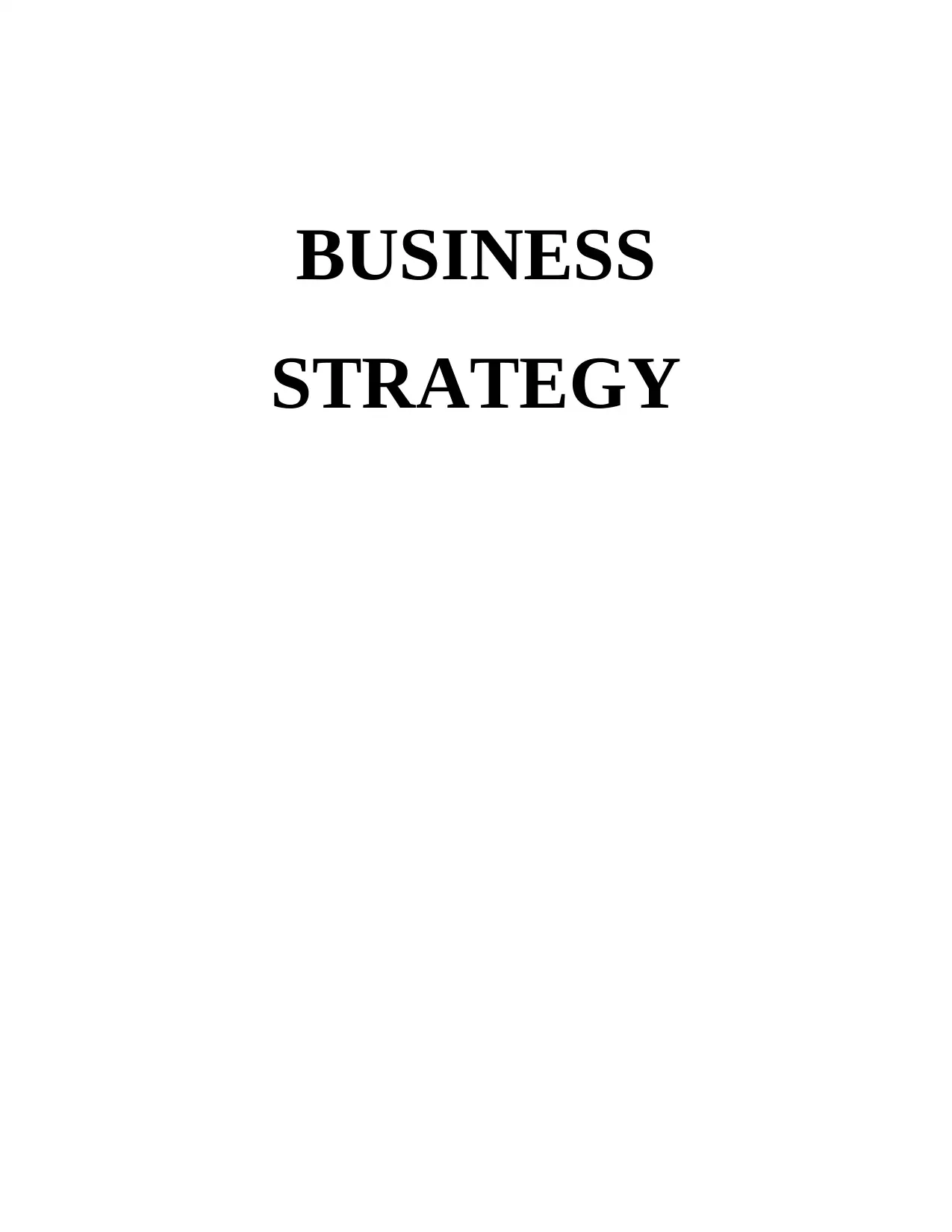
BUSINESS
STRATEGY
STRATEGY
Paraphrase This Document
Need a fresh take? Get an instant paraphrase of this document with our AI Paraphraser
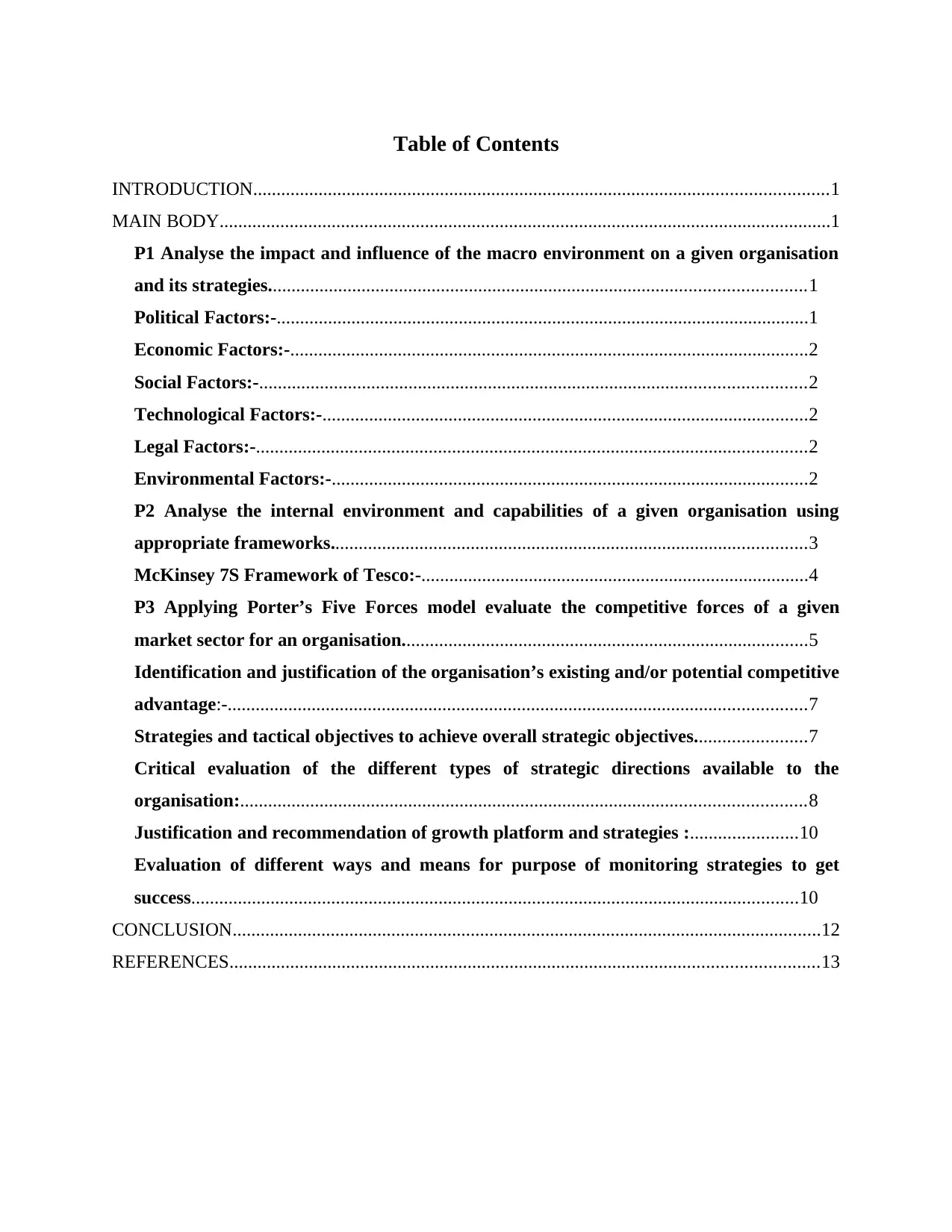
Table of Contents
INTRODUCTION...........................................................................................................................1
MAIN BODY...................................................................................................................................1
P1 Analyse the impact and influence of the macro environment on a given organisation
and its strategies...................................................................................................................1
Political Factors:-..................................................................................................................1
Economic Factors:-...............................................................................................................2
Social Factors:-.....................................................................................................................2
Technological Factors:-........................................................................................................2
Legal Factors:-......................................................................................................................2
Environmental Factors:-......................................................................................................2
P2 Analyse the internal environment and capabilities of a given organisation using
appropriate frameworks......................................................................................................3
McKinsey 7S Framework of Tesco:-...................................................................................4
P3 Applying Porter’s Five Forces model evaluate the competitive forces of a given
market sector for an organisation.......................................................................................5
Identification and justification of the organisation’s existing and/or potential competitive
advantage:-............................................................................................................................7
Strategies and tactical objectives to achieve overall strategic objectives........................7
Critical evaluation of the different types of strategic directions available to the
organisation:.........................................................................................................................8
Justification and recommendation of growth platform and strategies :.......................10
Evaluation of different ways and means for purpose of monitoring strategies to get
success..................................................................................................................................10
CONCLUSION..............................................................................................................................12
REFERENCES..............................................................................................................................13
INTRODUCTION...........................................................................................................................1
MAIN BODY...................................................................................................................................1
P1 Analyse the impact and influence of the macro environment on a given organisation
and its strategies...................................................................................................................1
Political Factors:-..................................................................................................................1
Economic Factors:-...............................................................................................................2
Social Factors:-.....................................................................................................................2
Technological Factors:-........................................................................................................2
Legal Factors:-......................................................................................................................2
Environmental Factors:-......................................................................................................2
P2 Analyse the internal environment and capabilities of a given organisation using
appropriate frameworks......................................................................................................3
McKinsey 7S Framework of Tesco:-...................................................................................4
P3 Applying Porter’s Five Forces model evaluate the competitive forces of a given
market sector for an organisation.......................................................................................5
Identification and justification of the organisation’s existing and/or potential competitive
advantage:-............................................................................................................................7
Strategies and tactical objectives to achieve overall strategic objectives........................7
Critical evaluation of the different types of strategic directions available to the
organisation:.........................................................................................................................8
Justification and recommendation of growth platform and strategies :.......................10
Evaluation of different ways and means for purpose of monitoring strategies to get
success..................................................................................................................................10
CONCLUSION..............................................................................................................................12
REFERENCES..............................................................................................................................13
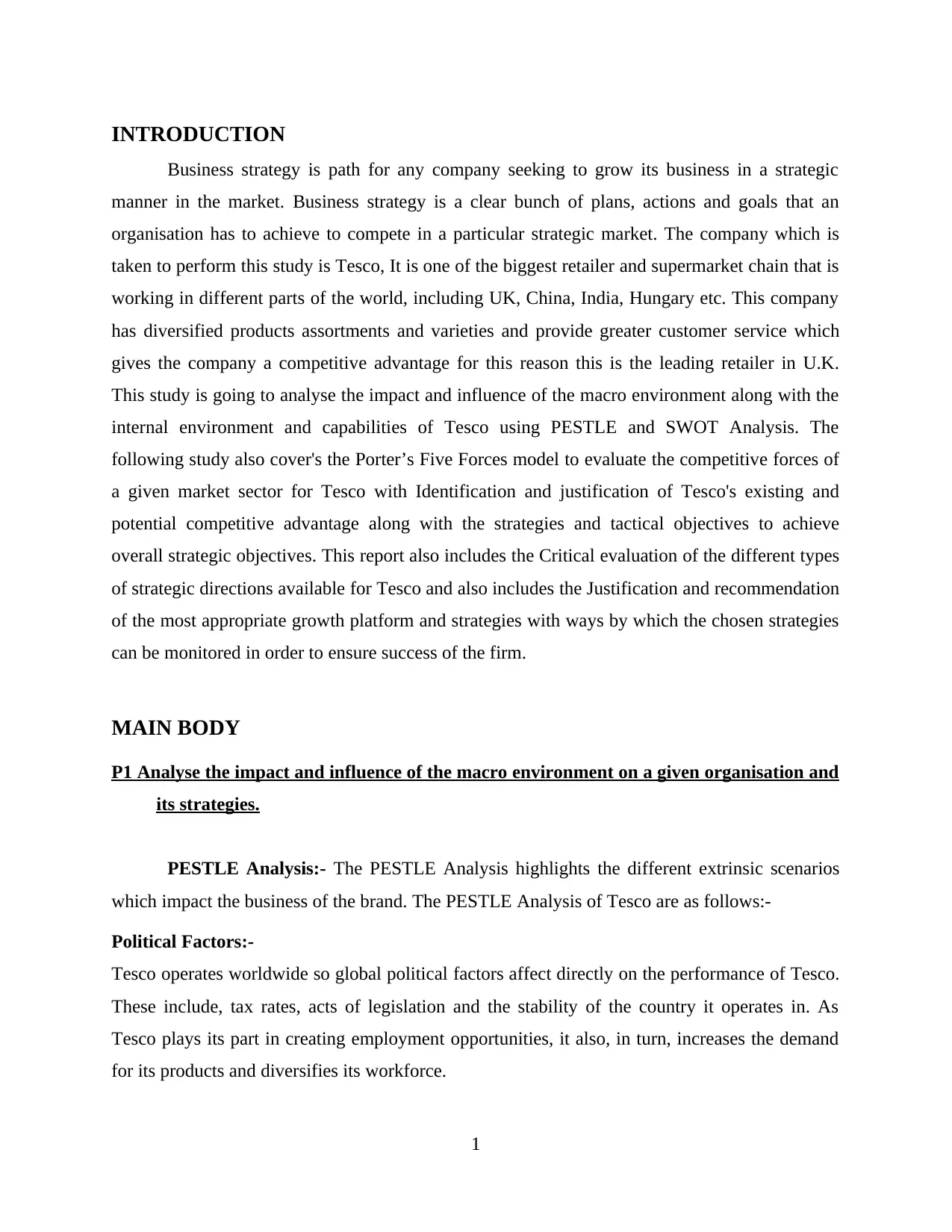
INTRODUCTION
Business strategy is path for any company seeking to grow its business in a strategic
manner in the market. Business strategy is a clear bunch of plans, actions and goals that an
organisation has to achieve to compete in a particular strategic market. The company which is
taken to perform this study is Tesco, It is one of the biggest retailer and supermarket chain that is
working in different parts of the world, including UK, China, India, Hungary etc. This company
has diversified products assortments and varieties and provide greater customer service which
gives the company a competitive advantage for this reason this is the leading retailer in U.K.
This study is going to analyse the impact and influence of the macro environment along with the
internal environment and capabilities of Tesco using PESTLE and SWOT Analysis. The
following study also cover's the Porter’s Five Forces model to evaluate the competitive forces of
a given market sector for Tesco with Identification and justification of Tesco's existing and
potential competitive advantage along with the strategies and tactical objectives to achieve
overall strategic objectives. This report also includes the Critical evaluation of the different types
of strategic directions available for Tesco and also includes the Justification and recommendation
of the most appropriate growth platform and strategies with ways by which the chosen strategies
can be monitored in order to ensure success of the firm.
MAIN BODY
P1 Analyse the impact and influence of the macro environment on a given organisation and
its strategies.
PESTLE Analysis:- The PESTLE Analysis highlights the different extrinsic scenarios
which impact the business of the brand. The PESTLE Analysis of Tesco are as follows:-
Political Factors:-
Tesco operates worldwide so global political factors affect directly on the performance of Tesco.
These include, tax rates, acts of legislation and the stability of the country it operates in. As
Tesco plays its part in creating employment opportunities, it also, in turn, increases the demand
for its products and diversifies its workforce.
1
Business strategy is path for any company seeking to grow its business in a strategic
manner in the market. Business strategy is a clear bunch of plans, actions and goals that an
organisation has to achieve to compete in a particular strategic market. The company which is
taken to perform this study is Tesco, It is one of the biggest retailer and supermarket chain that is
working in different parts of the world, including UK, China, India, Hungary etc. This company
has diversified products assortments and varieties and provide greater customer service which
gives the company a competitive advantage for this reason this is the leading retailer in U.K.
This study is going to analyse the impact and influence of the macro environment along with the
internal environment and capabilities of Tesco using PESTLE and SWOT Analysis. The
following study also cover's the Porter’s Five Forces model to evaluate the competitive forces of
a given market sector for Tesco with Identification and justification of Tesco's existing and
potential competitive advantage along with the strategies and tactical objectives to achieve
overall strategic objectives. This report also includes the Critical evaluation of the different types
of strategic directions available for Tesco and also includes the Justification and recommendation
of the most appropriate growth platform and strategies with ways by which the chosen strategies
can be monitored in order to ensure success of the firm.
MAIN BODY
P1 Analyse the impact and influence of the macro environment on a given organisation and
its strategies.
PESTLE Analysis:- The PESTLE Analysis highlights the different extrinsic scenarios
which impact the business of the brand. The PESTLE Analysis of Tesco are as follows:-
Political Factors:-
Tesco operates worldwide so global political factors affect directly on the performance of Tesco.
These include, tax rates, acts of legislation and the stability of the country it operates in. As
Tesco plays its part in creating employment opportunities, it also, in turn, increases the demand
for its products and diversifies its workforce.
1
⊘ This is a preview!⊘
Do you want full access?
Subscribe today to unlock all pages.

Trusted by 1+ million students worldwide
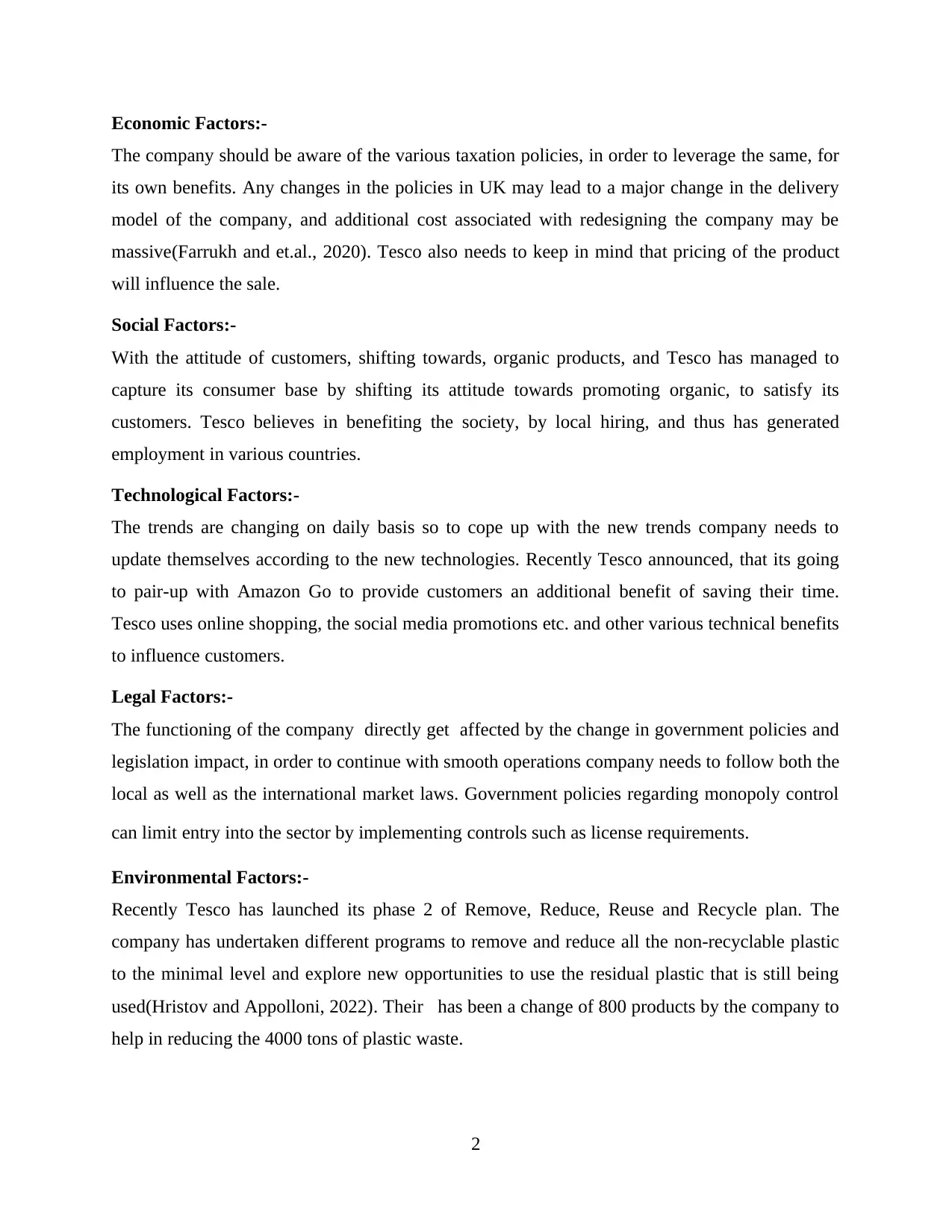
Economic Factors:-
The company should be aware of the various taxation policies, in order to leverage the same, for
its own benefits. Any changes in the policies in UK may lead to a major change in the delivery
model of the company, and additional cost associated with redesigning the company may be
massive(Farrukh and et.al., 2020). Tesco also needs to keep in mind that pricing of the product
will influence the sale.
Social Factors:-
With the attitude of customers, shifting towards, organic products, and Tesco has managed to
capture its consumer base by shifting its attitude towards promoting organic, to satisfy its
customers. Tesco believes in benefiting the society, by local hiring, and thus has generated
employment in various countries.
Technological Factors:-
The trends are changing on daily basis so to cope up with the new trends company needs to
update themselves according to the new technologies. Recently Tesco announced, that its going
to pair-up with Amazon Go to provide customers an additional benefit of saving their time.
Tesco uses online shopping, the social media promotions etc. and other various technical benefits
to influence customers.
Legal Factors:-
The functioning of the company directly get affected by the change in government policies and
legislation impact, in order to continue with smooth operations company needs to follow both the
local as well as the international market laws. Government policies regarding monopoly control
can limit entry into the sector by implementing controls such as license requirements.
Environmental Factors:-
Recently Tesco has launched its phase 2 of Remove, Reduce, Reuse and Recycle plan. The
company has undertaken different programs to remove and reduce all the non-recyclable plastic
to the minimal level and explore new opportunities to use the residual plastic that is still being
used(Hristov and Appolloni, 2022). Their has been a change of 800 products by the company to
help in reducing the 4000 tons of plastic waste.
2
The company should be aware of the various taxation policies, in order to leverage the same, for
its own benefits. Any changes in the policies in UK may lead to a major change in the delivery
model of the company, and additional cost associated with redesigning the company may be
massive(Farrukh and et.al., 2020). Tesco also needs to keep in mind that pricing of the product
will influence the sale.
Social Factors:-
With the attitude of customers, shifting towards, organic products, and Tesco has managed to
capture its consumer base by shifting its attitude towards promoting organic, to satisfy its
customers. Tesco believes in benefiting the society, by local hiring, and thus has generated
employment in various countries.
Technological Factors:-
The trends are changing on daily basis so to cope up with the new trends company needs to
update themselves according to the new technologies. Recently Tesco announced, that its going
to pair-up with Amazon Go to provide customers an additional benefit of saving their time.
Tesco uses online shopping, the social media promotions etc. and other various technical benefits
to influence customers.
Legal Factors:-
The functioning of the company directly get affected by the change in government policies and
legislation impact, in order to continue with smooth operations company needs to follow both the
local as well as the international market laws. Government policies regarding monopoly control
can limit entry into the sector by implementing controls such as license requirements.
Environmental Factors:-
Recently Tesco has launched its phase 2 of Remove, Reduce, Reuse and Recycle plan. The
company has undertaken different programs to remove and reduce all the non-recyclable plastic
to the minimal level and explore new opportunities to use the residual plastic that is still being
used(Hristov and Appolloni, 2022). Their has been a change of 800 products by the company to
help in reducing the 4000 tons of plastic waste.
2
Paraphrase This Document
Need a fresh take? Get an instant paraphrase of this document with our AI Paraphraser
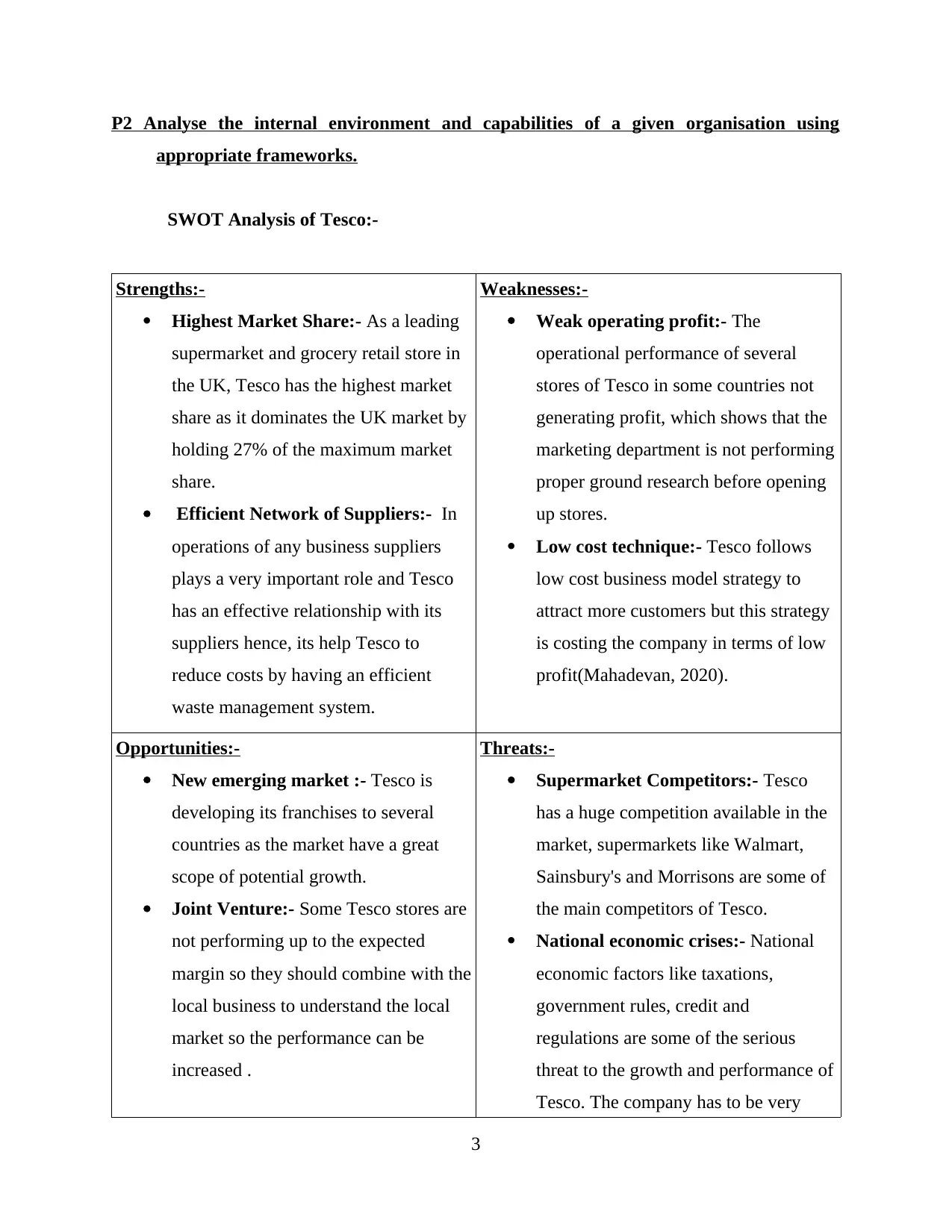
P2 Analyse the internal environment and capabilities of a given organisation using
appropriate frameworks.
SWOT Analysis of Tesco:-
Strengths:-
Highest Market Share:- As a leading
supermarket and grocery retail store in
the UK, Tesco has the highest market
share as it dominates the UK market by
holding 27% of the maximum market
share.
Efficient Network of Suppliers:- In
operations of any business suppliers
plays a very important role and Tesco
has an effective relationship with its
suppliers hence, its help Tesco to
reduce costs by having an efficient
waste management system.
Weaknesses:-
Weak operating profit:- The
operational performance of several
stores of Tesco in some countries not
generating profit, which shows that the
marketing department is not performing
proper ground research before opening
up stores.
Low cost technique:- Tesco follows
low cost business model strategy to
attract more customers but this strategy
is costing the company in terms of low
profit(Mahadevan, 2020).
Opportunities:-
New emerging market :- Tesco is
developing its franchises to several
countries as the market have a great
scope of potential growth.
Joint Venture:- Some Tesco stores are
not performing up to the expected
margin so they should combine with the
local business to understand the local
market so the performance can be
increased .
Threats:-
Supermarket Competitors:- Tesco
has a huge competition available in the
market, supermarkets like Walmart,
Sainsbury's and Morrisons are some of
the main competitors of Tesco.
National economic crises:- National
economic factors like taxations,
government rules, credit and
regulations are some of the serious
threat to the growth and performance of
Tesco. The company has to be very
3
appropriate frameworks.
SWOT Analysis of Tesco:-
Strengths:-
Highest Market Share:- As a leading
supermarket and grocery retail store in
the UK, Tesco has the highest market
share as it dominates the UK market by
holding 27% of the maximum market
share.
Efficient Network of Suppliers:- In
operations of any business suppliers
plays a very important role and Tesco
has an effective relationship with its
suppliers hence, its help Tesco to
reduce costs by having an efficient
waste management system.
Weaknesses:-
Weak operating profit:- The
operational performance of several
stores of Tesco in some countries not
generating profit, which shows that the
marketing department is not performing
proper ground research before opening
up stores.
Low cost technique:- Tesco follows
low cost business model strategy to
attract more customers but this strategy
is costing the company in terms of low
profit(Mahadevan, 2020).
Opportunities:-
New emerging market :- Tesco is
developing its franchises to several
countries as the market have a great
scope of potential growth.
Joint Venture:- Some Tesco stores are
not performing up to the expected
margin so they should combine with the
local business to understand the local
market so the performance can be
increased .
Threats:-
Supermarket Competitors:- Tesco
has a huge competition available in the
market, supermarkets like Walmart,
Sainsbury's and Morrisons are some of
the main competitors of Tesco.
National economic crises:- National
economic factors like taxations,
government rules, credit and
regulations are some of the serious
threat to the growth and performance of
Tesco. The company has to be very
3
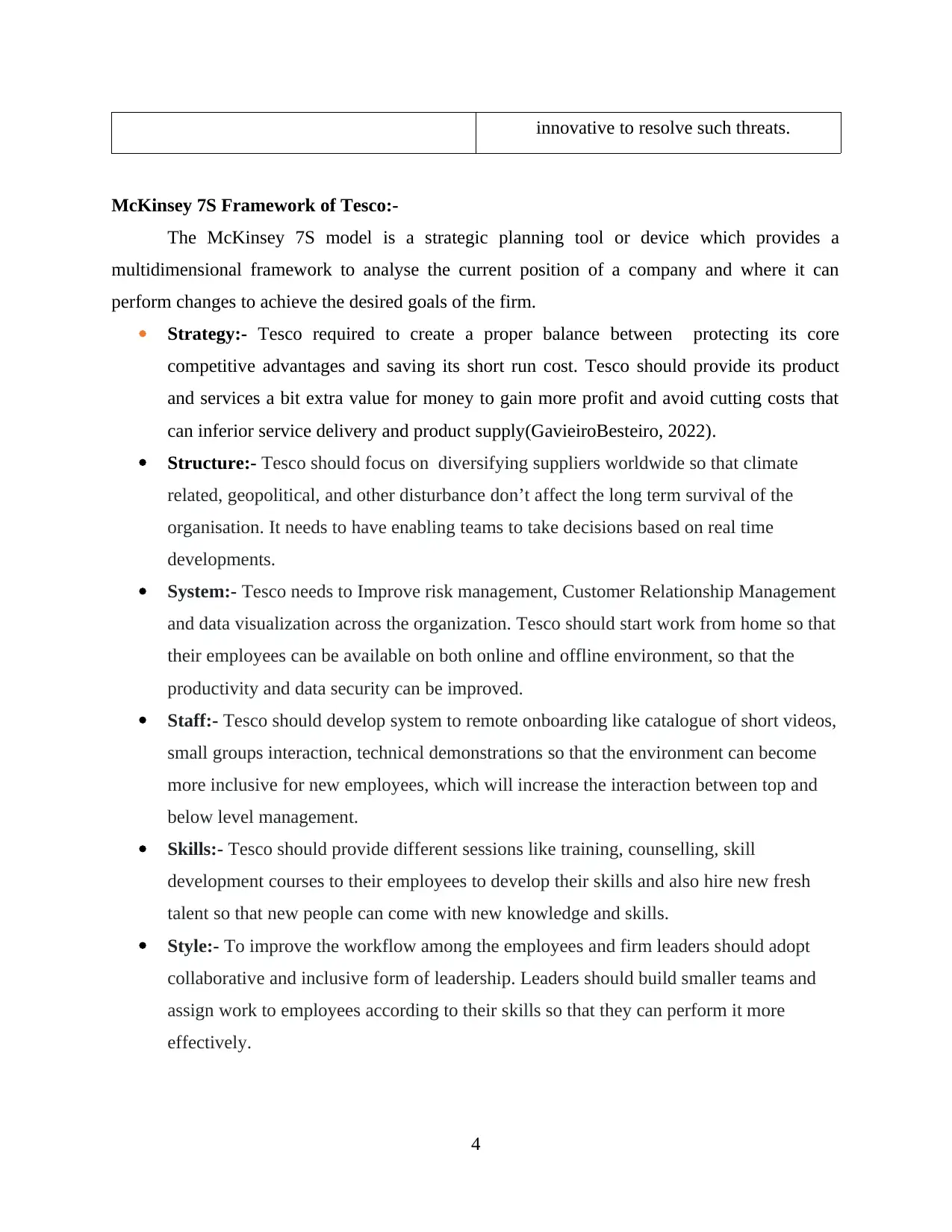
innovative to resolve such threats.
McKinsey 7S Framework of Tesco:-
The McKinsey 7S model is a strategic planning tool or device which provides a
multidimensional framework to analyse the current position of a company and where it can
perform changes to achieve the desired goals of the firm.
Strategy:- Tesco required to create a proper balance between protecting its core
competitive advantages and saving its short run cost. Tesco should provide its product
and services a bit extra value for money to gain more profit and avoid cutting costs that
can inferior service delivery and product supply(GavieiroBesteiro, 2022).
Structure:- Tesco should focus on diversifying suppliers worldwide so that climate
related, geopolitical, and other disturbance don’t affect the long term survival of the
organisation. It needs to have enabling teams to take decisions based on real time
developments.
System:- Tesco needs to Improve risk management, Customer Relationship Management
and data visualization across the organization. Tesco should start work from home so that
their employees can be available on both online and offline environment, so that the
productivity and data security can be improved.
Staff:- Tesco should develop system to remote onboarding like catalogue of short videos,
small groups interaction, technical demonstrations so that the environment can become
more inclusive for new employees, which will increase the interaction between top and
below level management.
Skills:- Tesco should provide different sessions like training, counselling, skill
development courses to their employees to develop their skills and also hire new fresh
talent so that new people can come with new knowledge and skills.
Style:- To improve the workflow among the employees and firm leaders should adopt
collaborative and inclusive form of leadership. Leaders should build smaller teams and
assign work to employees according to their skills so that they can perform it more
effectively.
4
McKinsey 7S Framework of Tesco:-
The McKinsey 7S model is a strategic planning tool or device which provides a
multidimensional framework to analyse the current position of a company and where it can
perform changes to achieve the desired goals of the firm.
Strategy:- Tesco required to create a proper balance between protecting its core
competitive advantages and saving its short run cost. Tesco should provide its product
and services a bit extra value for money to gain more profit and avoid cutting costs that
can inferior service delivery and product supply(GavieiroBesteiro, 2022).
Structure:- Tesco should focus on diversifying suppliers worldwide so that climate
related, geopolitical, and other disturbance don’t affect the long term survival of the
organisation. It needs to have enabling teams to take decisions based on real time
developments.
System:- Tesco needs to Improve risk management, Customer Relationship Management
and data visualization across the organization. Tesco should start work from home so that
their employees can be available on both online and offline environment, so that the
productivity and data security can be improved.
Staff:- Tesco should develop system to remote onboarding like catalogue of short videos,
small groups interaction, technical demonstrations so that the environment can become
more inclusive for new employees, which will increase the interaction between top and
below level management.
Skills:- Tesco should provide different sessions like training, counselling, skill
development courses to their employees to develop their skills and also hire new fresh
talent so that new people can come with new knowledge and skills.
Style:- To improve the workflow among the employees and firm leaders should adopt
collaborative and inclusive form of leadership. Leaders should build smaller teams and
assign work to employees according to their skills so that they can perform it more
effectively.
4
⊘ This is a preview!⊘
Do you want full access?
Subscribe today to unlock all pages.

Trusted by 1+ million students worldwide
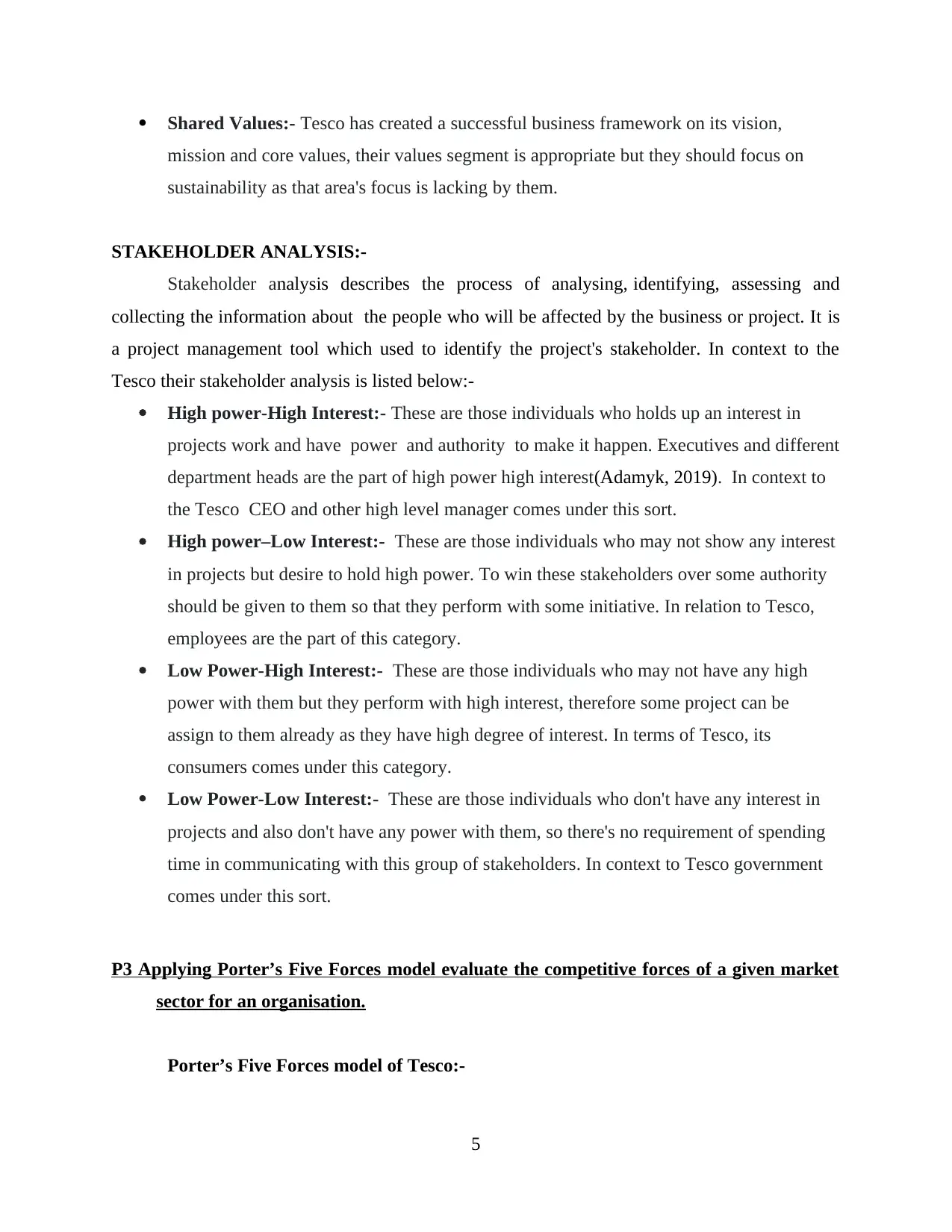
Shared Values:- Tesco has created a successful business framework on its vision,
mission and core values, their values segment is appropriate but they should focus on
sustainability as that area's focus is lacking by them.
STAKEHOLDER ANALYSIS:-
Stakeholder analysis describes the process of analysing, identifying, assessing and
collecting the information about the people who will be affected by the business or project. It is
a project management tool which used to identify the project's stakeholder. In context to the
Tesco their stakeholder analysis is listed below:-
High power-High Interest:- These are those individuals who holds up an interest in
projects work and have power and authority to make it happen. Executives and different
department heads are the part of high power high interest(Adamyk, 2019). In context to
the Tesco CEO and other high level manager comes under this sort.
High power–Low Interest:- These are those individuals who may not show any interest
in projects but desire to hold high power. To win these stakeholders over some authority
should be given to them so that they perform with some initiative. In relation to Tesco,
employees are the part of this category.
Low Power-High Interest:- These are those individuals who may not have any high
power with them but they perform with high interest, therefore some project can be
assign to them already as they have high degree of interest. In terms of Tesco, its
consumers comes under this category.
Low Power-Low Interest:- These are those individuals who don't have any interest in
projects and also don't have any power with them, so there's no requirement of spending
time in communicating with this group of stakeholders. In context to Tesco government
comes under this sort.
P3 Applying Porter’s Five Forces model evaluate the competitive forces of a given market
sector for an organisation.
Porter’s Five Forces model of Tesco:-
5
mission and core values, their values segment is appropriate but they should focus on
sustainability as that area's focus is lacking by them.
STAKEHOLDER ANALYSIS:-
Stakeholder analysis describes the process of analysing, identifying, assessing and
collecting the information about the people who will be affected by the business or project. It is
a project management tool which used to identify the project's stakeholder. In context to the
Tesco their stakeholder analysis is listed below:-
High power-High Interest:- These are those individuals who holds up an interest in
projects work and have power and authority to make it happen. Executives and different
department heads are the part of high power high interest(Adamyk, 2019). In context to
the Tesco CEO and other high level manager comes under this sort.
High power–Low Interest:- These are those individuals who may not show any interest
in projects but desire to hold high power. To win these stakeholders over some authority
should be given to them so that they perform with some initiative. In relation to Tesco,
employees are the part of this category.
Low Power-High Interest:- These are those individuals who may not have any high
power with them but they perform with high interest, therefore some project can be
assign to them already as they have high degree of interest. In terms of Tesco, its
consumers comes under this category.
Low Power-Low Interest:- These are those individuals who don't have any interest in
projects and also don't have any power with them, so there's no requirement of spending
time in communicating with this group of stakeholders. In context to Tesco government
comes under this sort.
P3 Applying Porter’s Five Forces model evaluate the competitive forces of a given market
sector for an organisation.
Porter’s Five Forces model of Tesco:-
5
Paraphrase This Document
Need a fresh take? Get an instant paraphrase of this document with our AI Paraphraser

Bargaining Power of buyers:-
The bargaining power of buyers is a large number of competing retailers in the market. The
products provided by the store are mainly those which fulfil the basic needs of the customers, the
prices for basic goods are same across all retail stores and the quality of products will also be the
same(Richardson, 2019). Thus the bargaining power of buyers can be assumed to be low.
Bargaining Power of Suppliers:-
Suppliers have comparatively less bargaining power when it comes to the products offered by
Tesco. Switching from one supplier to another is not a big task for Tesco. The negotiation power
is with the retailers only, they decides the price as there are multiple suppliers available for the
items.
Competitive Rivalry:-
Tesco has intense competition from Walmart, Sainsbury's, ASDA etc. They all are well
established firms with strong supply chains and logistic networks. The major breakthroughs are
brought in by advertising and other marketing techniques. Companies try to position themselves
different from their competitors through their diverse marketing campaigns.
Threat of New Entrants:-
Tesco is a multinational retailer focusing on general merchandise, which is one of the largest
retailers across the world. Setting up a store requires huge amount of capital. Besides, competing
against an established brand like Tesco and providing discounts or offers is not easy for new
entrants they find difficulty in accessing the distribution the channels and supply chains already
dominated by the big firms(Villagrasa, Sánchez and Donaldson, 2022). Thus, the threat of new
entrants is a weak force concerning Tesco.
Threat of Substitutes:-
Tesco sells the basic needs products thus, the threat of substitute is very minimum. People might
prefer to buy from them since these products cater to the daily needs of people. Tesco is known
for its finest product lines which gives it an upper hand in the market.
6
The bargaining power of buyers is a large number of competing retailers in the market. The
products provided by the store are mainly those which fulfil the basic needs of the customers, the
prices for basic goods are same across all retail stores and the quality of products will also be the
same(Richardson, 2019). Thus the bargaining power of buyers can be assumed to be low.
Bargaining Power of Suppliers:-
Suppliers have comparatively less bargaining power when it comes to the products offered by
Tesco. Switching from one supplier to another is not a big task for Tesco. The negotiation power
is with the retailers only, they decides the price as there are multiple suppliers available for the
items.
Competitive Rivalry:-
Tesco has intense competition from Walmart, Sainsbury's, ASDA etc. They all are well
established firms with strong supply chains and logistic networks. The major breakthroughs are
brought in by advertising and other marketing techniques. Companies try to position themselves
different from their competitors through their diverse marketing campaigns.
Threat of New Entrants:-
Tesco is a multinational retailer focusing on general merchandise, which is one of the largest
retailers across the world. Setting up a store requires huge amount of capital. Besides, competing
against an established brand like Tesco and providing discounts or offers is not easy for new
entrants they find difficulty in accessing the distribution the channels and supply chains already
dominated by the big firms(Villagrasa, Sánchez and Donaldson, 2022). Thus, the threat of new
entrants is a weak force concerning Tesco.
Threat of Substitutes:-
Tesco sells the basic needs products thus, the threat of substitute is very minimum. People might
prefer to buy from them since these products cater to the daily needs of people. Tesco is known
for its finest product lines which gives it an upper hand in the market.
6
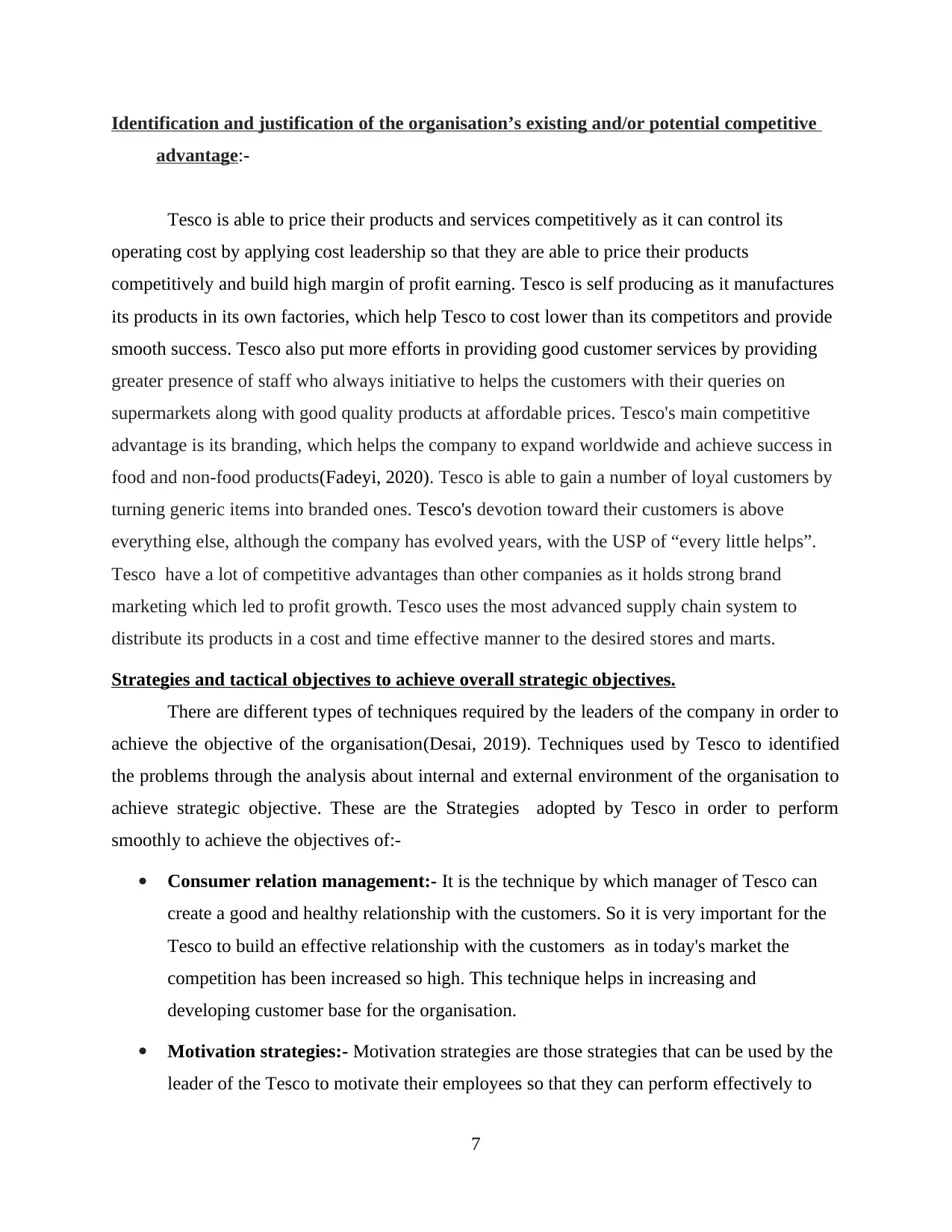
Identification and justification of the organisation’s existing and/or potential competitive
advantage:-
Tesco is able to price their products and services competitively as it can control its
operating cost by applying cost leadership so that they are able to price their products
competitively and build high margin of profit earning. Tesco is self producing as it manufactures
its products in its own factories, which help Tesco to cost lower than its competitors and provide
smooth success. Tesco also put more efforts in providing good customer services by providing
greater presence of staff who always initiative to helps the customers with their queries on
supermarkets along with good quality products at affordable prices. Tesco's main competitive
advantage is its branding, which helps the company to expand worldwide and achieve success in
food and non-food products(Fadeyi, 2020). Tesco is able to gain a number of loyal customers by
turning generic items into branded ones. Tesco's devotion toward their customers is above
everything else, although the company has evolved years, with the USP of “every little helps”.
Tesco have a lot of competitive advantages than other companies as it holds strong brand
marketing which led to profit growth. Tesco uses the most advanced supply chain system to
distribute its products in a cost and time effective manner to the desired stores and marts.
Strategies and tactical objectives to achieve overall strategic objectives.
There are different types of techniques required by the leaders of the company in order to
achieve the objective of the organisation(Desai, 2019). Techniques used by Tesco to identified
the problems through the analysis about internal and external environment of the organisation to
achieve strategic objective. These are the Strategies adopted by Tesco in order to perform
smoothly to achieve the objectives of:-
Consumer relation management:- It is the technique by which manager of Tesco can
create a good and healthy relationship with the customers. So it is very important for the
Tesco to build an effective relationship with the customers as in today's market the
competition has been increased so high. This technique helps in increasing and
developing customer base for the organisation.
Motivation strategies:- Motivation strategies are those strategies that can be used by the
leader of the Tesco to motivate their employees so that they can perform effectively to
7
advantage:-
Tesco is able to price their products and services competitively as it can control its
operating cost by applying cost leadership so that they are able to price their products
competitively and build high margin of profit earning. Tesco is self producing as it manufactures
its products in its own factories, which help Tesco to cost lower than its competitors and provide
smooth success. Tesco also put more efforts in providing good customer services by providing
greater presence of staff who always initiative to helps the customers with their queries on
supermarkets along with good quality products at affordable prices. Tesco's main competitive
advantage is its branding, which helps the company to expand worldwide and achieve success in
food and non-food products(Fadeyi, 2020). Tesco is able to gain a number of loyal customers by
turning generic items into branded ones. Tesco's devotion toward their customers is above
everything else, although the company has evolved years, with the USP of “every little helps”.
Tesco have a lot of competitive advantages than other companies as it holds strong brand
marketing which led to profit growth. Tesco uses the most advanced supply chain system to
distribute its products in a cost and time effective manner to the desired stores and marts.
Strategies and tactical objectives to achieve overall strategic objectives.
There are different types of techniques required by the leaders of the company in order to
achieve the objective of the organisation(Desai, 2019). Techniques used by Tesco to identified
the problems through the analysis about internal and external environment of the organisation to
achieve strategic objective. These are the Strategies adopted by Tesco in order to perform
smoothly to achieve the objectives of:-
Consumer relation management:- It is the technique by which manager of Tesco can
create a good and healthy relationship with the customers. So it is very important for the
Tesco to build an effective relationship with the customers as in today's market the
competition has been increased so high. This technique helps in increasing and
developing customer base for the organisation.
Motivation strategies:- Motivation strategies are those strategies that can be used by the
leader of the Tesco to motivate their employees so that they can perform effectively to
7
⊘ This is a preview!⊘
Do you want full access?
Subscribe today to unlock all pages.

Trusted by 1+ million students worldwide
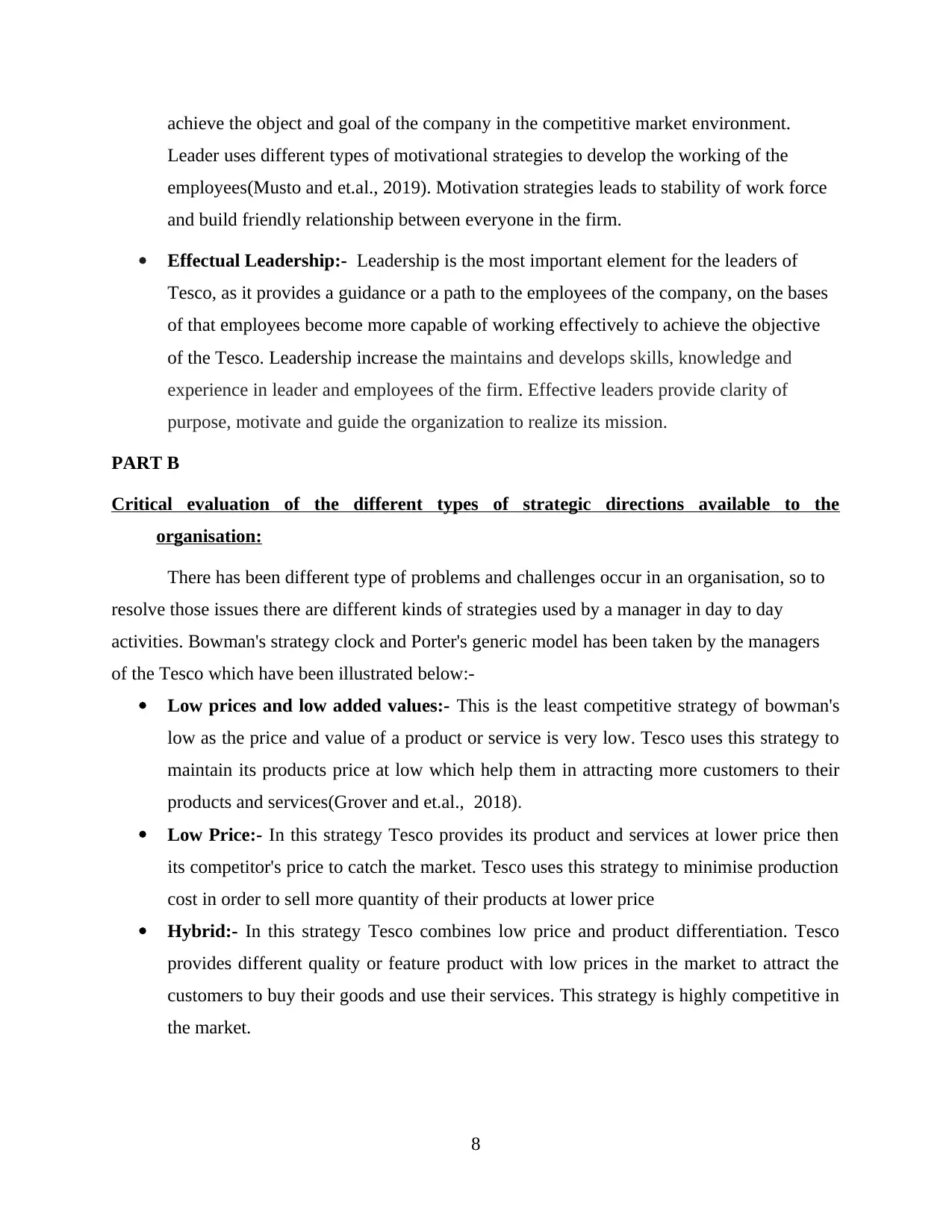
achieve the object and goal of the company in the competitive market environment.
Leader uses different types of motivational strategies to develop the working of the
employees(Musto and et.al., 2019). Motivation strategies leads to stability of work force
and build friendly relationship between everyone in the firm.
Effectual Leadership:- Leadership is the most important element for the leaders of
Tesco, as it provides a guidance or a path to the employees of the company, on the bases
of that employees become more capable of working effectively to achieve the objective
of the Tesco. Leadership increase the maintains and develops skills, knowledge and
experience in leader and employees of the firm. Effective leaders provide clarity of
purpose, motivate and guide the organization to realize its mission.
PART B
Critical evaluation of the different types of strategic directions available to the
organisation:
There has been different type of problems and challenges occur in an organisation, so to
resolve those issues there are different kinds of strategies used by a manager in day to day
activities. Bowman's strategy clock and Porter's generic model has been taken by the managers
of the Tesco which have been illustrated below:-
Low prices and low added values:- This is the least competitive strategy of bowman's
low as the price and value of a product or service is very low. Tesco uses this strategy to
maintain its products price at low which help them in attracting more customers to their
products and services(Grover and et.al., 2018).
Low Price:- In this strategy Tesco provides its product and services at lower price then
its competitor's price to catch the market. Tesco uses this strategy to minimise production
cost in order to sell more quantity of their products at lower price
Hybrid:- In this strategy Tesco combines low price and product differentiation. Tesco
provides different quality or feature product with low prices in the market to attract the
customers to buy their goods and use their services. This strategy is highly competitive in
the market.
8
Leader uses different types of motivational strategies to develop the working of the
employees(Musto and et.al., 2019). Motivation strategies leads to stability of work force
and build friendly relationship between everyone in the firm.
Effectual Leadership:- Leadership is the most important element for the leaders of
Tesco, as it provides a guidance or a path to the employees of the company, on the bases
of that employees become more capable of working effectively to achieve the objective
of the Tesco. Leadership increase the maintains and develops skills, knowledge and
experience in leader and employees of the firm. Effective leaders provide clarity of
purpose, motivate and guide the organization to realize its mission.
PART B
Critical evaluation of the different types of strategic directions available to the
organisation:
There has been different type of problems and challenges occur in an organisation, so to
resolve those issues there are different kinds of strategies used by a manager in day to day
activities. Bowman's strategy clock and Porter's generic model has been taken by the managers
of the Tesco which have been illustrated below:-
Low prices and low added values:- This is the least competitive strategy of bowman's
low as the price and value of a product or service is very low. Tesco uses this strategy to
maintain its products price at low which help them in attracting more customers to their
products and services(Grover and et.al., 2018).
Low Price:- In this strategy Tesco provides its product and services at lower price then
its competitor's price to catch the market. Tesco uses this strategy to minimise production
cost in order to sell more quantity of their products at lower price
Hybrid:- In this strategy Tesco combines low price and product differentiation. Tesco
provides different quality or feature product with low prices in the market to attract the
customers to buy their goods and use their services. This strategy is highly competitive in
the market.
8
Paraphrase This Document
Need a fresh take? Get an instant paraphrase of this document with our AI Paraphraser
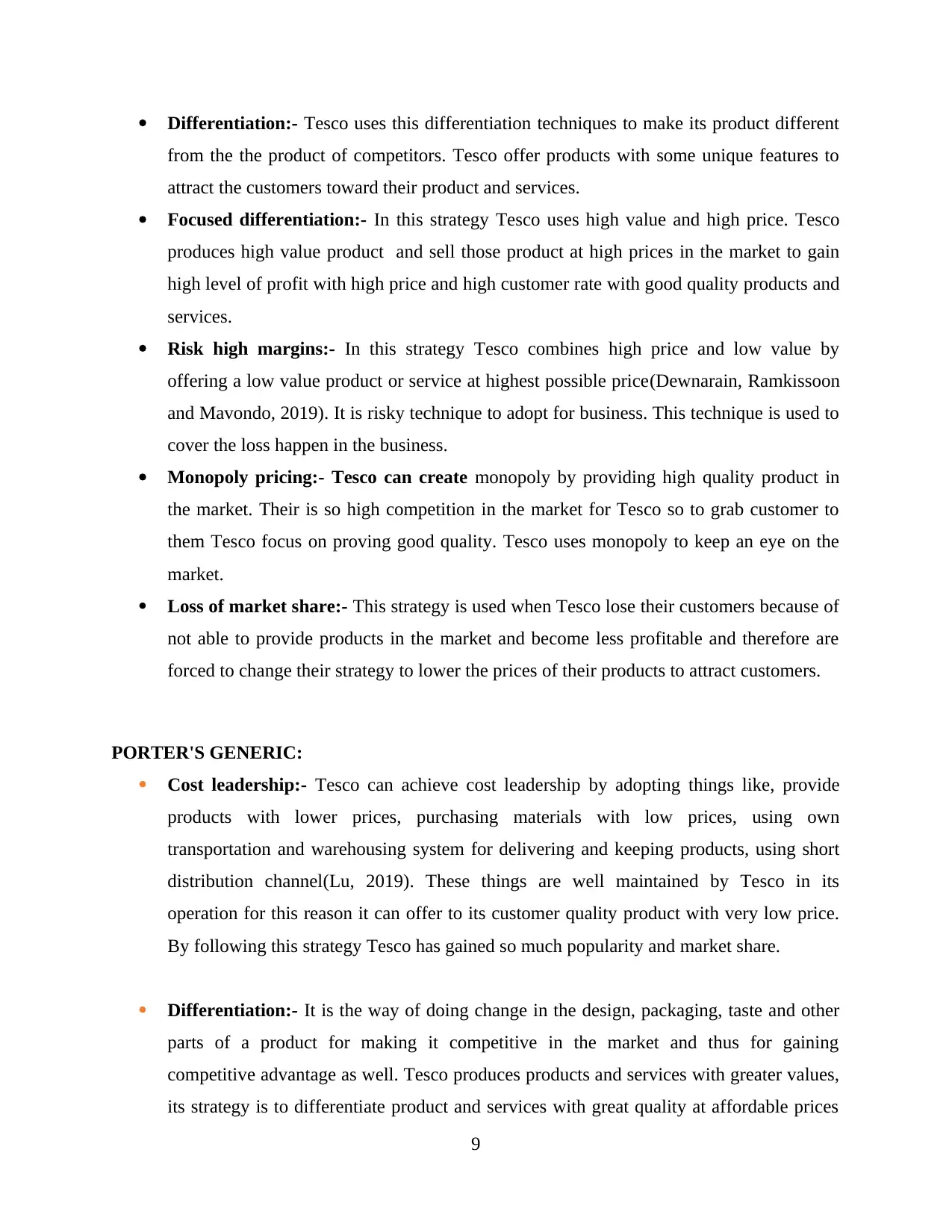
Differentiation:- Tesco uses this differentiation techniques to make its product different
from the the product of competitors. Tesco offer products with some unique features to
attract the customers toward their product and services.
Focused differentiation:- In this strategy Tesco uses high value and high price. Tesco
produces high value product and sell those product at high prices in the market to gain
high level of profit with high price and high customer rate with good quality products and
services.
Risk high margins:- In this strategy Tesco combines high price and low value by
offering a low value product or service at highest possible price(Dewnarain, Ramkissoon
and Mavondo, 2019). It is risky technique to adopt for business. This technique is used to
cover the loss happen in the business.
Monopoly pricing:- Tesco can create monopoly by providing high quality product in
the market. Their is so high competition in the market for Tesco so to grab customer to
them Tesco focus on proving good quality. Tesco uses monopoly to keep an eye on the
market.
Loss of market share:- This strategy is used when Tesco lose their customers because of
not able to provide products in the market and become less profitable and therefore are
forced to change their strategy to lower the prices of their products to attract customers.
PORTER'S GENERIC:
Cost leadership:- Tesco can achieve cost leadership by adopting things like, provide
products with lower prices, purchasing materials with low prices, using own
transportation and warehousing system for delivering and keeping products, using short
distribution channel(Lu, 2019). These things are well maintained by Tesco in its
operation for this reason it can offer to its customer quality product with very low price.
By following this strategy Tesco has gained so much popularity and market share.
Differentiation:- It is the way of doing change in the design, packaging, taste and other
parts of a product for making it competitive in the market and thus for gaining
competitive advantage as well. Tesco produces products and services with greater values,
its strategy is to differentiate product and services with great quality at affordable prices
9
from the the product of competitors. Tesco offer products with some unique features to
attract the customers toward their product and services.
Focused differentiation:- In this strategy Tesco uses high value and high price. Tesco
produces high value product and sell those product at high prices in the market to gain
high level of profit with high price and high customer rate with good quality products and
services.
Risk high margins:- In this strategy Tesco combines high price and low value by
offering a low value product or service at highest possible price(Dewnarain, Ramkissoon
and Mavondo, 2019). It is risky technique to adopt for business. This technique is used to
cover the loss happen in the business.
Monopoly pricing:- Tesco can create monopoly by providing high quality product in
the market. Their is so high competition in the market for Tesco so to grab customer to
them Tesco focus on proving good quality. Tesco uses monopoly to keep an eye on the
market.
Loss of market share:- This strategy is used when Tesco lose their customers because of
not able to provide products in the market and become less profitable and therefore are
forced to change their strategy to lower the prices of their products to attract customers.
PORTER'S GENERIC:
Cost leadership:- Tesco can achieve cost leadership by adopting things like, provide
products with lower prices, purchasing materials with low prices, using own
transportation and warehousing system for delivering and keeping products, using short
distribution channel(Lu, 2019). These things are well maintained by Tesco in its
operation for this reason it can offer to its customer quality product with very low price.
By following this strategy Tesco has gained so much popularity and market share.
Differentiation:- It is the way of doing change in the design, packaging, taste and other
parts of a product for making it competitive in the market and thus for gaining
competitive advantage as well. Tesco produces products and services with greater values,
its strategy is to differentiate product and services with great quality at affordable prices
9
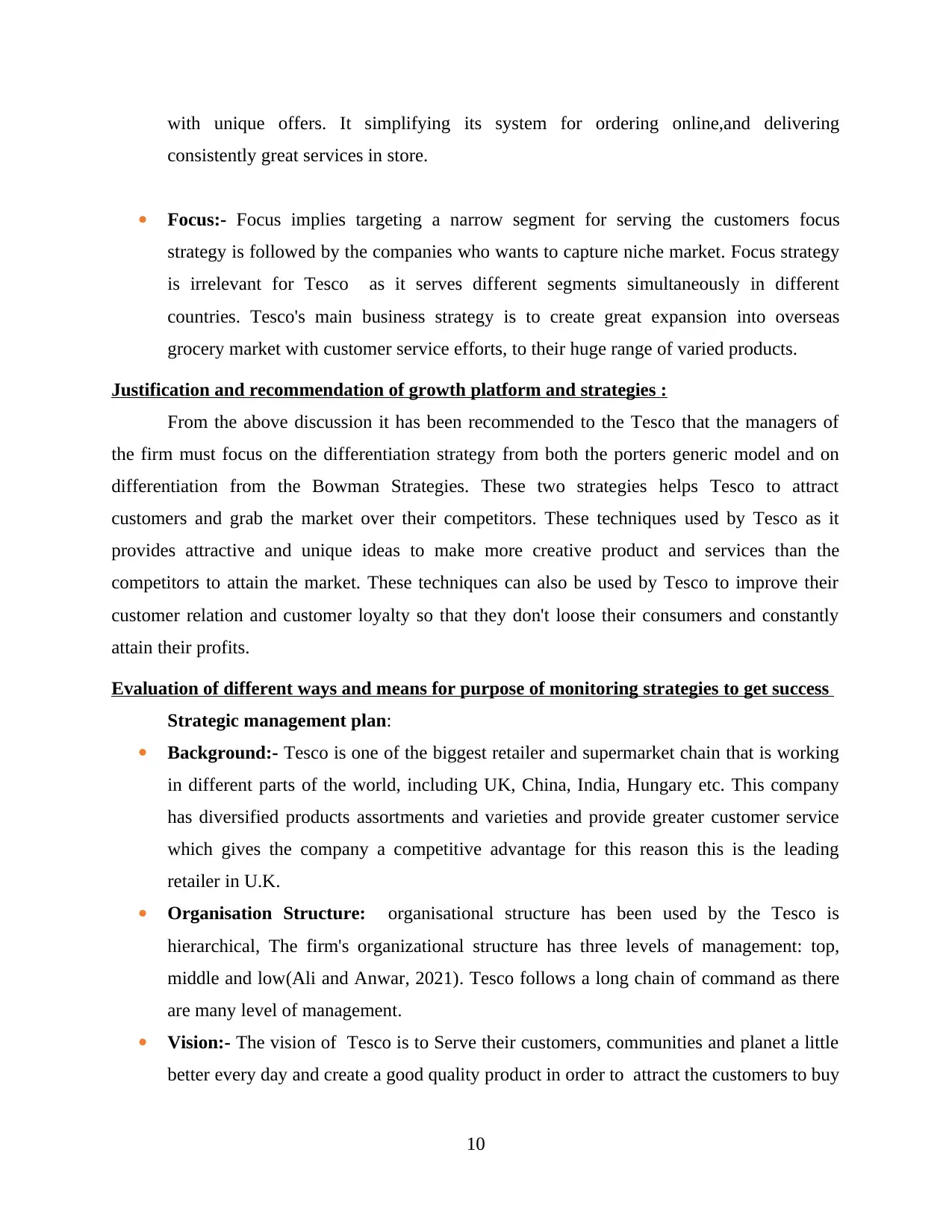
with unique offers. It simplifying its system for ordering online,and delivering
consistently great services in store.
Focus:- Focus implies targeting a narrow segment for serving the customers focus
strategy is followed by the companies who wants to capture niche market. Focus strategy
is irrelevant for Tesco as it serves different segments simultaneously in different
countries. Tesco's main business strategy is to create great expansion into overseas
grocery market with customer service efforts, to their huge range of varied products.
Justification and recommendation of growth platform and strategies :
From the above discussion it has been recommended to the Tesco that the managers of
the firm must focus on the differentiation strategy from both the porters generic model and on
differentiation from the Bowman Strategies. These two strategies helps Tesco to attract
customers and grab the market over their competitors. These techniques used by Tesco as it
provides attractive and unique ideas to make more creative product and services than the
competitors to attain the market. These techniques can also be used by Tesco to improve their
customer relation and customer loyalty so that they don't loose their consumers and constantly
attain their profits.
Evaluation of different ways and means for purpose of monitoring strategies to get success
Strategic management plan:
Background:- Tesco is one of the biggest retailer and supermarket chain that is working
in different parts of the world, including UK, China, India, Hungary etc. This company
has diversified products assortments and varieties and provide greater customer service
which gives the company a competitive advantage for this reason this is the leading
retailer in U.K.
Organisation Structure: organisational structure has been used by the Tesco is
hierarchical, The firm's organizational structure has three levels of management: top,
middle and low(Ali and Anwar, 2021). Tesco follows a long chain of command as there
are many level of management.
Vision:- The vision of Tesco is to Serve their customers, communities and planet a little
better every day and create a good quality product in order to attract the customers to buy
10
consistently great services in store.
Focus:- Focus implies targeting a narrow segment for serving the customers focus
strategy is followed by the companies who wants to capture niche market. Focus strategy
is irrelevant for Tesco as it serves different segments simultaneously in different
countries. Tesco's main business strategy is to create great expansion into overseas
grocery market with customer service efforts, to their huge range of varied products.
Justification and recommendation of growth platform and strategies :
From the above discussion it has been recommended to the Tesco that the managers of
the firm must focus on the differentiation strategy from both the porters generic model and on
differentiation from the Bowman Strategies. These two strategies helps Tesco to attract
customers and grab the market over their competitors. These techniques used by Tesco as it
provides attractive and unique ideas to make more creative product and services than the
competitors to attain the market. These techniques can also be used by Tesco to improve their
customer relation and customer loyalty so that they don't loose their consumers and constantly
attain their profits.
Evaluation of different ways and means for purpose of monitoring strategies to get success
Strategic management plan:
Background:- Tesco is one of the biggest retailer and supermarket chain that is working
in different parts of the world, including UK, China, India, Hungary etc. This company
has diversified products assortments and varieties and provide greater customer service
which gives the company a competitive advantage for this reason this is the leading
retailer in U.K.
Organisation Structure: organisational structure has been used by the Tesco is
hierarchical, The firm's organizational structure has three levels of management: top,
middle and low(Ali and Anwar, 2021). Tesco follows a long chain of command as there
are many level of management.
Vision:- The vision of Tesco is to Serve their customers, communities and planet a little
better every day and create a good quality product in order to attract the customers to buy
10
⊘ This is a preview!⊘
Do you want full access?
Subscribe today to unlock all pages.

Trusted by 1+ million students worldwide
1 out of 16
Related Documents
Your All-in-One AI-Powered Toolkit for Academic Success.
+13062052269
info@desklib.com
Available 24*7 on WhatsApp / Email
![[object Object]](/_next/static/media/star-bottom.7253800d.svg)
Unlock your academic potential
Copyright © 2020–2025 A2Z Services. All Rights Reserved. Developed and managed by ZUCOL.

